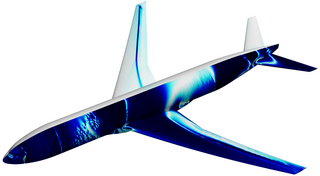In fluid dynamics, turbulence or turbulent flow is fluid motion characterized by chaotic changes in pressure and flow velocity. It is in contrast to a laminar flow, which occurs when a fluid flows in parallel layers, with no disruption between those layers.
In fluid dynamics, a gravity current or density current is a primarily horizontal flow in a gravitational field that is driven by a density difference in a fluid or fluids and is constrained to flow horizontally by, for instance, a ceiling. Typically, the density difference is small enough for the Boussinesq approximation to be valid. Gravity currents can be thought of as either finite in volume, such as the pyroclastic flow from a volcano eruption, or continuously supplied from a source, such as warm air leaving the open doorway of a house in winter. Other examples include dust storms, turbidity currents, avalanches, discharge from wastewater or industrial processes into rivers, or river discharge into the ocean.
A vacuum ejector, or simply ejector is a type of vacuum pump, which produces vacuum by means of the Venturi effect.

An injector is a system of ducting and nozzles used to direct the flow of a high-pressure fluid in such a way that a lower pressure fluid is entrained in the jet and carried through a duct to a region of higher pressure. It is a fluid-dynamic pump with no moving parts except a valve to control inlet flow.

In fluid dynamics, turbulence modeling is the construction and use of a mathematical model to predict the effects of turbulence. Turbulent flows are commonplace in most real-life scenarios, including the flow of blood through the cardiovascular system, the airflow over an aircraft wing, the re-entry of space vehicles, besides others. In spite of decades of research, there is no analytical theory to predict the evolution of these turbulent flows. The equations governing turbulent flows can only be solved directly for simple cases of flow. For most real-life turbulent flows, CFD simulations use turbulent models to predict the evolution of turbulence. These turbulence models are simplified constitutive equations that predict the statistical evolution of turbulent flows.

In hydrodynamics, a plume or a column is a vertical body of one fluid moving through another. Several effects control the motion of the fluid, including momentum (inertia), diffusion and buoyancy. Pure jets and pure plumes define flows that are driven entirely by momentum and buoyancy effects, respectively. Flows between these two limits are usually described as forced plumes or buoyant jets. "Buoyancy is defined as being positive" when, in the absence of other forces or initial motion, the entering fluid would tend to rise. Situations where the density of the plume fluid is greater than its surroundings, but the flow has sufficient initial momentum to carry it some distance vertically, are described as being negatively buoyant.

Roddam Narasimha FRS was an Indian aerospace scientist and fluid dynamicist. He was a professor of Aerospace Engineering at the Indian Institute of Science (1962–1999), director of the National Aerospace Laboratories (1984–1993) and the chairman of the Engineering Mechanics Unit at Jawaharlal Nehru Centre for Advanced Scientific Research. He was the DST Year-of-Science Chair Professor at JNCASR and concurrently held the Pratt & Whitney Chair in Science and Engineering at the University of Hyderabad. Narasimha was awarded the Padma Vibhushan, India's second-highest civilian award, in 2013. for his contributions to advance India's aerospace technology.

A bedform is a geological feature that develops at the interface of fluid and a moveable bed, the result of bed material being moved by fluid flow. Examples include ripples and dunes on the bed of a river. Bedforms are often preserved in the rock record as a result of being present in a depositional setting. Bedforms are often characteristic to the flow parameters, and may be used to infer flow depth and velocity, and therefore the Froude number.
Adrian Edmund Gill FRS was an Australian meteorologist and oceanographer best known for his textbook Atmosphere-Ocean Dynamics. Gill was born in Melbourne Australia and worked at Cambridge, serving as Senior Research Fellow from 1963 to 1984. His father was Edmund Gill, geologist, palaeontologist and curator at the National Museum of Victoria.

John Stewart Turner FAA FRS was an Australian geophysicist.
The Stuart number (N), also known as magnetic interaction parameter, is a dimensionless number of fluids, i.e. gases or liquids.
In fluid dynamics, and oceanography, Langmuir turbulence is a turbulent flow with coherent Langmuir circulation structures that exist and evolve over a range of spatial and temporal scales. These structures arise through an interaction between the ocean surface waves and the currents.
The term gravity current intrusion denotes the fluid mechanics phenomenon within which a fluid intrudes with a predominantly horizontal motion into a separate stratified fluid, typically along a plane of neutral buoyancy. This behaviour distinguishes the difference between gravity current intrusions and gravity currents, as intrusions are not restrained by a well-defined boundary surface. As with gravity currents, intrusion flow is driven within a gravity field by density differences typically small enough to allow for the Boussinesq approximation.
Multiscale turbulence is a class of turbulent flows in which the chaotic motion of the fluid is forced at different length and/or time scales. This is usually achieved by immersing in a moving fluid a body with a multiscale, often fractal-like, arrangement of length scales. This arrangement of scales can be either passive or active
Dwight Barkley is a professor of mathematics at the University of Warwick.
Owen Martin Phillips was a U.S. physical oceanographer and geophysicist who spent most of his career at the Johns Hopkins University.

Joseph Katz is an Israel-born American fluid dynamicist, known for his work on experimental fluid mechanics, cavitation phenomena and multiphase flow, turbulence, turbomachinery flows and oceanography flows, flow-induced vibrations and noise, and development of optical flow diagnostics techniques, including Particle Image Velocimetry (PIV) and Holographic Particle Image Velocimetry (HPIV). As of 2005, he is the William F. Ward Sr. Distinguished Professor at the Department of Mechanical Engineering of the Whiting School of Engineering at the Johns Hopkins University.

Rajat Mittal is a computational fluid dynamicist and a professor of mechanical engineering in the Whiting School of Engineering at Johns Hopkins University. He holds a secondary appointment in the Johns Hopkins University School of Medicine. He is known for his work on immersed boundary methods (IBMs) and applications of these methods to the study of fluid flow problems.

Jørgen Fredsøe (1947) is a Danish hydraulic engineer who is recognized for his contributions within bed form dynamics in rivers and the marine environment and coastal morphology including bars and beach undulations. Together with professor B. Mutlu Sumer he initiated the research on scour (erosion) in the seabed around coastal structures applying detailed hydrodynamic interpretations. He was born in Randers, Denmark.
Bruce Morton was an Australian/New Zealand applied mathematician.








